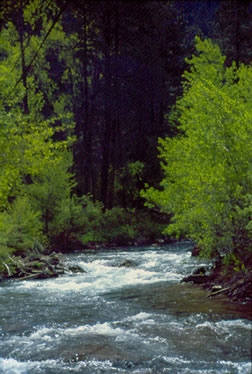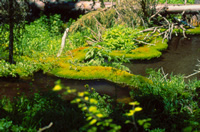History -- Muir & Black Hills National Forest
John Muir in Spearfish Canyon
John Muir, 1838-1914, explorer, writer, and conservationist is considered the most famous naturalist in America. His devotion to conservancy of forested landscapes throughout the west, particularly the California redwoods, Yosemite, the Sierra Nevada mountain range, and the Alaskan glaciers, is heralded even today, nearly one-hundred years later. To discover that John Muir was in the Black Hills in 1896 and, quite possibly, Spearfish Canyon is an historical treasure worthy of note.
In the 1840's, through the doctrine of Manifest Destiny, the hardy and brave of spirit had opened the Western frontier to new commerce at a rapid pace. America's expansion to the Pacific instilled a deeply entrenched laissez-faire philosophy in public land use and acquisition. As the frontier was disappearing, a new somber mood was rising across America. Americans, choked by the smokestacks of their new urban lifestyles, began to elevate 'Nature' as an ideal.
Through the activities of Muir, and many scientists, foresters, scholars, and writers in the growing conservation movement, efforts were underway to modify public laws governing development of natural resources on public lands and to protect certain forested lands from sale to private interests. The European model of forest management that realized a direct influence of forests upon climate, soil, and water flow was highly regarded. Those decade-long efforts came to fruition in 1891 with the adoption of the Forest Reserve Act which amended the general land laws of the United States. The omnibus bill contained a short sixty-word 'sleeper' clause (its late submittal flouted congressional rules, was not printed in the Federal Register, and no debate as Congress was in an end-of session rush) known as the Bowers clause, or Section 24. It allowed the President by proclamation to reserve any forest land in the public domain.
In 1893 the federal government had proposed setting aside 20 million acres in fifteen locations as forest reserves. The first site listed was the Black Hills of South Dakota. Muir noted that the Resere Plan "will prove a glorious reformation and make the pine needles tingle with joy".
But, Congress had no interest in that notion and the idea faded. Three years later, however, at the constant urging of conservationists, the Department of Interior directed the National Academy of Sciences to form a National Forestry Commission to survey the problems of the western forests and recommend solutions. Six members were appointed to the Commission: Charles Sargent, director of Harvard's Arnold Arboretum, William Brewer of Yale; General Henry Abbott, US Engineer Corps; Alexander Agassiz of Harvard; Arnold Hague of the U.S. Geological Survey; and Gifford Pinchot, a young forester of prominence. John Muir had asked to be passed over for the appointment because of ill health, but agreed to serve as an unofficial advisor and travel with them on occasion.
A few months later, Muir accompanied four of the commissioners on their western tour and to the scene of their first inquiry, the ponderosa forests of the Black Hills. There they found trees ravaged by fire, grazing, mining operations, and illegal logging; and the story would continue much the same wherever they went...the Big Horn Mountains in Wyoming, the Tetons near Yellowstone; the Lewis and Clark, and Flat Head in Montana; the Priest River in Idaho; the Bitterroot Range in Idaho and Montana, the Cascade Mountains in Washington, the coast redwood belt in northern California, several Big Tree groves in the Sierra Nevada, the San Bernardino Reserve in southern California, San Jacinto Mountains, the Grand Canyon, and five reserves in Colorado.
Pinchot-Muir Debate - The Nation's Public Lands
 The Commission's final report was announced by President Cleveland in May of 1897 through an executive order withdrawing 13 Forest Reserves as recommended by the Commission. Thereupon erupted a deafening debate that resounded throughout the west. This great debate of public lands caused a schism in the conservation movement; conservation lead by Pinchot and preservation lead by Muir. Would these great bodies of Reserve lands be withdrawn from all occupation and use, or would they perform their part in the economy of the nation? Who would manage these vast areas, the Army as Muir supported, or a civil service as Pinchot recommended? The report pointed out the important relationship between the forests and climate, soils, and stream flow. It noted that forest fires and sheep grazing were the greatest environmental threats to the forest environment. It recommended that the Reserves must be managed for the benefit of the whole country, not for any particular class or section. It acknowledged that the Reserves needed civil administration, and that fees paid to the government for natural resource development were appropriate. It had recommended a geological survey of each Reserve. (A copy of the first survey in 1899 is part of the Latchstring Collection and is display at the Foundation office) It noted that public laws were inadequate, and that their interpretation was inviting fraud. Below are excerpts from the Black Hills Report: The Commission's final report was announced by President Cleveland in May of 1897 through an executive order withdrawing 13 Forest Reserves as recommended by the Commission. Thereupon erupted a deafening debate that resounded throughout the west. This great debate of public lands caused a schism in the conservation movement; conservation lead by Pinchot and preservation lead by Muir. Would these great bodies of Reserve lands be withdrawn from all occupation and use, or would they perform their part in the economy of the nation? Who would manage these vast areas, the Army as Muir supported, or a civil service as Pinchot recommended? The report pointed out the important relationship between the forests and climate, soils, and stream flow. It noted that forest fires and sheep grazing were the greatest environmental threats to the forest environment. It recommended that the Reserves must be managed for the benefit of the whole country, not for any particular class or section. It acknowledged that the Reserves needed civil administration, and that fees paid to the government for natural resource development were appropriate. It had recommended a geological survey of each Reserve. (A copy of the first survey in 1899 is part of the Latchstring Collection and is display at the Foundation office) It noted that public laws were inadequate, and that their interpretation was inviting fraud. Below are excerpts from the Black Hills Report:
"The mountains in this proposed reserve are covered with forests of yellow pine, and in the valleys between them spruces and cottonwoods principally occupy the ground. These forests are entirely isolated and afford the only timber which is produced in the territory between Minnesota on the east and the Big Horn Mountains of Wyoming and the Rocky Mountains on the west. The region contains a number of mines which depend on these forests for timber and fuel, and the settlers in the valleys of streams flowing from them have no other timber or fuel supply. It appears important, therefore, that these forests should be protected and made permanently productive , and that they should continue to guard the sources of the numerous streams which head in the Black Hills and are essential to the irrigation of the desert region adjacent to their courses. The Forests on the proposed reserve have suffered seriously from fire and the illegal cutting of timber and fuel taken from the public domain. It is evident that without Government protection these forests, so far as their productive capacity is concerned, will disappear at the end of a few years, and that their destruction will entail serious injury and loss to the agricultural and mining population."
Black Hills Forest Reserve - Establishment of the Nation's Public Policy
Eventually, public policy was adopted to implement natural resource withdrawal incuding no development in National Parks and multiple use and resource development in National Forests.
Thirteen Forest Reserves were recommended for adoption, and two, Arizona's Grand Canyon and Washington's Mount Ranier, were suggested for National Park status. In late 1897, Congress passed the Forest Management Act (Organic Act) making explicit the purpose of Forest Reserves as resources for lumbering, watershed development, mining, and grazing. In 1905, President Teddy Roosevelt, a frequent visitor to Spearfish Canyon, signed the Transfer Act. This act created the US Forest Service under the Department of Agriculture, and the Reserves were reclassified as National Forests. Glifford Pinchot was appointed Forest Chief. Muir's concern for the destruction of the 200-million old petrified forests in Arizona, New Mexico, and California caused him to write and speak for their protection. In 1906, Congress established the American Antiquities Act authorizing the President to establish national monuments for the preservation of features of historic and scientific interests. Roosevelt immediately proclaimed Devils Tower of Wyoming, just west of the Black Hills, the first National Monument.
John Muir acknowledged the value of "sustained-yield...use of timber for economic development...under careful and thoughtful circumstances. However, his focus and dedication remained in the preservation of public lands through the development of National Parks. He has been called the "father" of America's national park system.
Although there is nothing in the report that confirms that Muir and the Commission visited Spearfish Canyon, it may be fair to assume they were since much of their report highlighted timber activities, railroads, and major watercourses, all of which were prevalent in the Canyon at the time. It could also be argued that they did not, for had they seen it, they may have pushed for Spearfish Canyon as a national park as Muir had done so many times in preserving other landscapes of supreme natural beauty.
John Muir was born in Dunbar, Scotland, and in 1849, at the age of eleven, the Muir family immigrated to the United States settling on a dairy farm near Portage, Wisconsin. His eventual exploration and prolific writings of America's woodlands established him as one of the leading naturalists of the time. Muir drew attention to the devastation of mountains, meadows and forests by fires and the trespass of natural resource development and use on public lands. Muir's love of the high country gave his writings a spiritual quality. His readers, whether they be presidents, congressman, or plain folk, were inspired and often moved by the enthusiasm of Muir's own unqualified love of nature.
"Everybody needs beauty as well as bread, places to play in and pray in, where Nature may heal and cheer and give strength to body and soul alike"
In 1892, Muir helped establish the Sierra Club and was elected its first president, an office he would hold for the rest of his life. The Club's purpose was recreation, education, and conservation, namely "to explore, enjoy, and render accessible the mountain regions of the Pacific Coast" |


